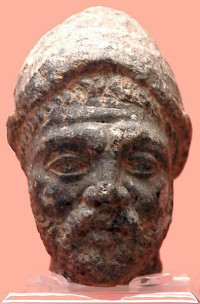Pacorus II
Pacorus II: Arsacid king of the Parthian Empire (r.78-105).

In 78 CE, the Parthian king Vologases I died. He was succeeded by Vologases II, who appears to have claimed that he was Vologases' son, and by Pacorus II, who was, like Vologases I, a son of Vonones I and a Greek concubine. The details about the civil war are unknown, but in 80, Pacorus was in control of the full Parthian Empire.
Media Atropatene
During the reign of his brother, i.e., from 51 to 78, Pacorus had been viceroy of Media Atropatene (more or less the province of Azerbaijan in modern Iran). This part of the Parthian Empire had been in the frontline in the conflict that broke out in 52, when Vologases had intervened in Armenia and had made a third brother, Tiridates, king of this country. A great war with Rome, which lasted until 63, had been the consequence. During this war, the pro-Roman king Tigranes VI had raided Media Atropatene.
In 72, the Alans had crossed the Caucasus Mountains and invaded the Parthian Empire. Again, Media Atropatene was a frontier zone, but the Alans soon returned to the plains of Central Eurasia.
King of Parthia
About Pacorus' reign, we only know that he exchanged letters and presents with Decebalus, king of the Dacians,note sold Edessa, the capital of Osrhoene, to Abgar VII,note had a conflict with the Roman emperor Trajan,note and that he expanded Ctesiphon and built its city walls.note He also put his son Axidares on the throne in Armenia, who would later be succeeded by another son of Pacorus, Parthamasiris.
From coinage and a remark by the Byzantine author Zonaras,note we know that Pacorus was faced with at least two insurrections in the eastern part of the empire: Artabanus III (from c.80 to c.90) and Vologases III (in c.105). This last rebellion was still going on when Pacorus died in 105. His brother Osroes I succeeded him and inherited the conflict with Vologases III.
Note
The chronology of the Arsacid kings of the Parthian Empire is less well-understood than, for example, the sequence of Seleucid and Ptolemaic kings or the emperors of Rome. This information is based on the researches by G.R.F. Assar, as published in "Iran under the Arsakids, 247 BC – AD 224/227" in: Numismatic Art of Persia (2011).